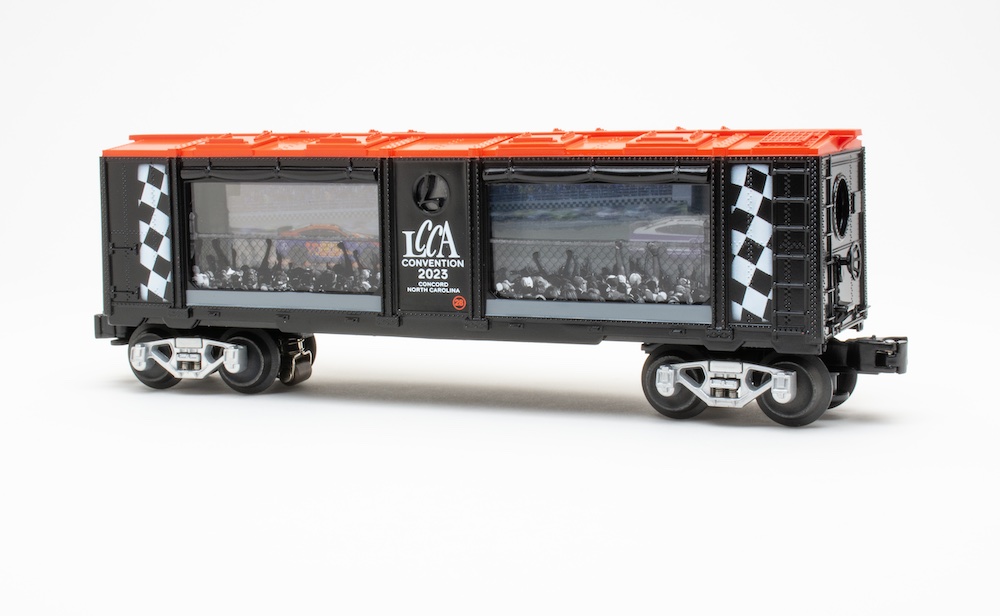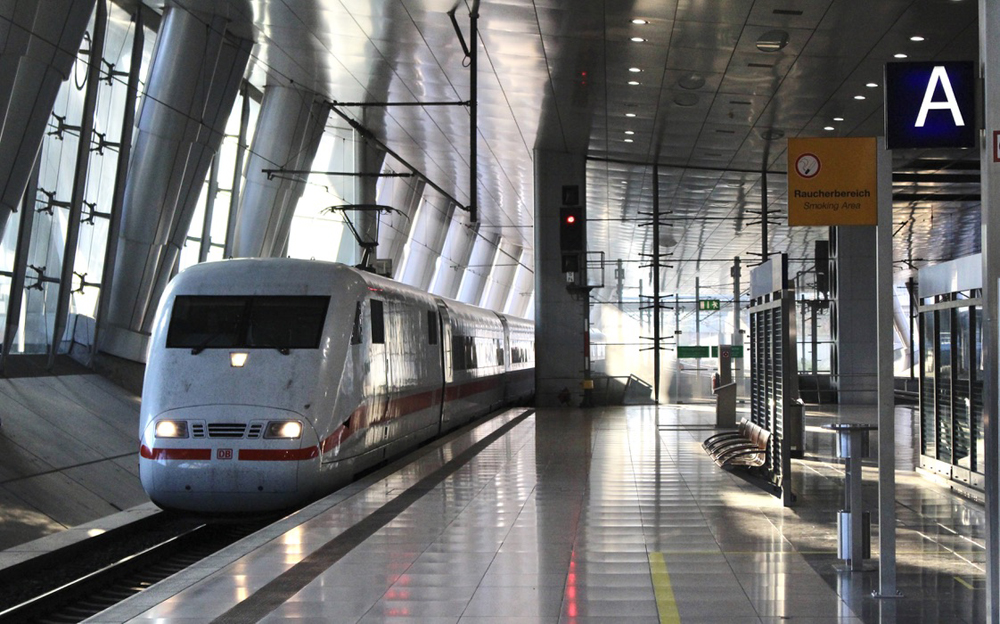WILMERDING, Pa. — Locomotive maker Wabtec is amping up promotion of its coming main line battery-powered locomotive. On Sunday, the Wilmerding-based rail supplier posted a new video to YouTube highlighting the proposed workings and benefits of a battery-powered locomotive for main line running.
The approximately 3-minute video shows artists renderings of the locomotive along with cutaway drawings to discuss certain components.














Jumping off Ian’s thought, why not a battery car that could collect the dynamic braking power from the locomotives and then feed it back to them to reduce the amount of diesel required.
This is Wabtec responding to California’s Green New Deal hype and restrictions/incentives, with some SJW language for a bonus.
Simply put, every modern Diesel Electric is a hybrid waiting for enough storage capacity. Even the best battery under current technology would have to be far larger than the locomotive itself to store all the energy being thrown away by the Dynamic Brakes. Then there is the truth that chemical batteries have a problem with rapid charge/discharge cycles. It tears them up fast, which is why you need batteries much larger than the apparent demand.
This could be met better by capacitors as they are built for rapid charge and discharge, and some lab demonstrations have the same capacity as Li batteries. I suspect the reason capacitors have been largely ignored is they are not good at long term storage, where a day or two is about it. But they would be perfect for this as long term storage is not needed and they could be more closely matched to demand as over capacity is not needed. Just remember that if things go horribly wrong it’s like several sticks of dynamite went off. If they became universal several “boiler explosions” would be happening again as routine.
Strange that the people pushing these things don’t seem to understand basic math and physics.
Just a thought, why couldn’t WABTEC grab all the energy from the dynamic brake systems in a locomotive consist by having jumper cables between locomotives and the battery locomotive. Basically you would turn the dynamic brakes into regenerative brakes and using the power to charge the batteries.
Don’t ask me I’m just a worn out dumb twuck driver. Usual disclaimers apply.
This could be a quiet comfortable lead locomotive for crews.
For Joe and others… This is almost entirely a regenerative braking play – like a hybrid car. Nearly all of the energy going into the batteries is coming from dynamic braking. The wayside charging is going to be a tiny piece of this.
What one wouldn’t do to avoid electrification of the rail network through catenaries. Batteries are not efficient for mainline use and they have a terrible life cycle cost, requiring huge amounts of lithium and rare minerals (most of which are mined in China, btw).
So, we’re going to drag around a whole locomotive just to hold batteries for regenerative braking. And, the battery locomotive has four traction motors. And the whole deal uses trip optimizer.
Not a terrible way to go.
So, here’s how it might play out. At initial terminal, the batteries are topped off. The train hits the road and uses the batteries to batteries to help get the train up to speed quicker. The trip optimizer knows where and when the next braking event will occur and where where the hills are. So, it allows the batteries to get to half full before cutting off the battery power. The train cruises along and comes to a meet. The train goes into dynamic braking and recharges the batteries to full.
The train leaves the siding and starts upgrade. The batteries are allowed to drain nearly empty. The train crests the grade and uses DB down the other side, The batteries get charged nearly full.
The train then cruises along to the next meet. The batteries are used such that they are half full at the meet point. DB charges them back to full and and then are used down to half full again accelerating the train.
Since the trip optimizer has a good idea of what’s coming, it can “dial in” the most desirable battery usage.
Pretty smart. Kind of a “poor man’s” electrification. (except those batteries won’t be cheap!)
Green energy lol. Solar charging stations along right of way hey. Future looks bright.
At 4400HP, about 45 minutes. This is about regenerative braking with local storage. Not exactly a new idea; modern electric locomotives have the ability to dump regenerative braking energy back into the catenary for use by other trains…
This is so cool! I wonder if the (former) fuel tank is filled with ballast or if that is a useful space for more batteries in future models? It can put out 4,400 hp, but for how long? How powerful is the regenerative braking? When used in a hybrid consist, how much maintenance does it save on its diesel counterparts? (Presumably the extra traction will be used only for accelerating or hill climbing, which is when the most strain is put on the diesel engines, like a hybrid car works.)
I hope TRAINS keeps following the development of this tech!
Think the idea is terrific and would work equally well with electric or even steam, with somewhat different programming in the trip optimiser, of course. Absolutely no reason it should not work well, provided they have solved, are solving, or will solve the remaining problems with existing trip optimisers and/or allow simple and effective and efficient manual control.
Batteries are not an efficient way to power anything. And what gen erates the electricity that will recharge them? There is nothing “green” about the elements that go into batteries!
Cool, can’t wait to see the performance reports of a working model.
This is more PR stunt than real product…probably because NYAB beat them in the accursed automation race. No Class 1 buys 4 axle locomotives for heavy haul anymore and it would create a whole fleet with separate maintenance requirements…. I only see it selling to UP and BNSF for California operations. If they could put an energy storage device on a traditional diesel…that might be something. If electric operations are the goal…why not string centenary?
The problem with the hybrid consist is that the dynamic regeneration will only happen on the battery loco.
Tyler John Carelli,
See the current Wabtec/GE Evolution Series Model ES44C4, a 6-axle model with 4 traction motors…doesn’t need to be a 4-axle unit.
Jim Norton,
News isn’t free, consider yourself lucky that you can even see some of it…if they wanted to subscribers are the only ones that could see the news as well as post…and unlike some outfits like the Wall Street Journal and Forbes, I’m at least willing to pay for a Trains subscription, neither of those other two(as well as many other paid news sites) have news I’m the least bit interested in…if it’s not free(supported by advertisers, not subscribers) it’s not news for me(Trains is different, not much advertising to be had realistically speaking).
Seems like a workable concept, use one of these in a 3-4 loco consist the dynamic braking effect of the total number of locomotives could keep the batteries charged for when the extra power is needed. As for 4 motor only power a lot of the AC locomotives have 2 motors per 3 axle trucks.
Shhhhh. No one tell Elon Musk about this.
I would rather see a Loco with an on-board battery cell for increased acceleration. Something akin to the boost mode on Siemens Charger Loco’s.
Jim Norton,,,,ya wanna play, ya gotta pay..like the rest of us. The only thing in life that’s free is love and sometimes I wonder about that.
Jim Norton: Subscribers pay the freight. -Eds.
Correction. Not applicable to modern electrikfication, since regenerative braking already makes braking energy available to other trains to cliimb and/or accelerating. Might be useful with steam, however.
Short of greed I can’t imagine why Kalmbach chooses to withhold so many news stories as for subscribers only?
Editorial note it is kw-hr not kw/hr. watts are already joules/hour and a rate. Total storage is joules or watt-hour
@Don Oltmann: I see the same thing with the scenario you laid out. As far as the batteries expense, its true, but capacity to make them is rising so quickly, the cost is declining very quickly as well. While others are worried about the battery capacity, I worry about the cooling capacity, especially in tunnel work. Those LI’s generate a lot of heat when they are exercised and don’t tolerate high temps as well as traction motors do.